Hockey holds a significant place in Keweenaw history. As you drive into Houghton via US-41, you will see the iconic sign that reads, “Welcome to the Birthplace of Professional Hockey.” The region’s enduring love for the winter sport can be traced back through generations, with hockey becoming a cultural cornerstone for both recreation and competition throughout our region. Follow along to learn more about ice hockey’s special place in Keweenaw history.
Houghton’s Indoor Arenas
Birthplace of Professional Hockey – The Dee Stadium
Houghton’s designation as the Birthplace of Professional Hockey originates at the location of the present-day Dee Stadium. The Dee Stadium was built in 1928 after the original Amphidrome ice arena burnt down in 1927.
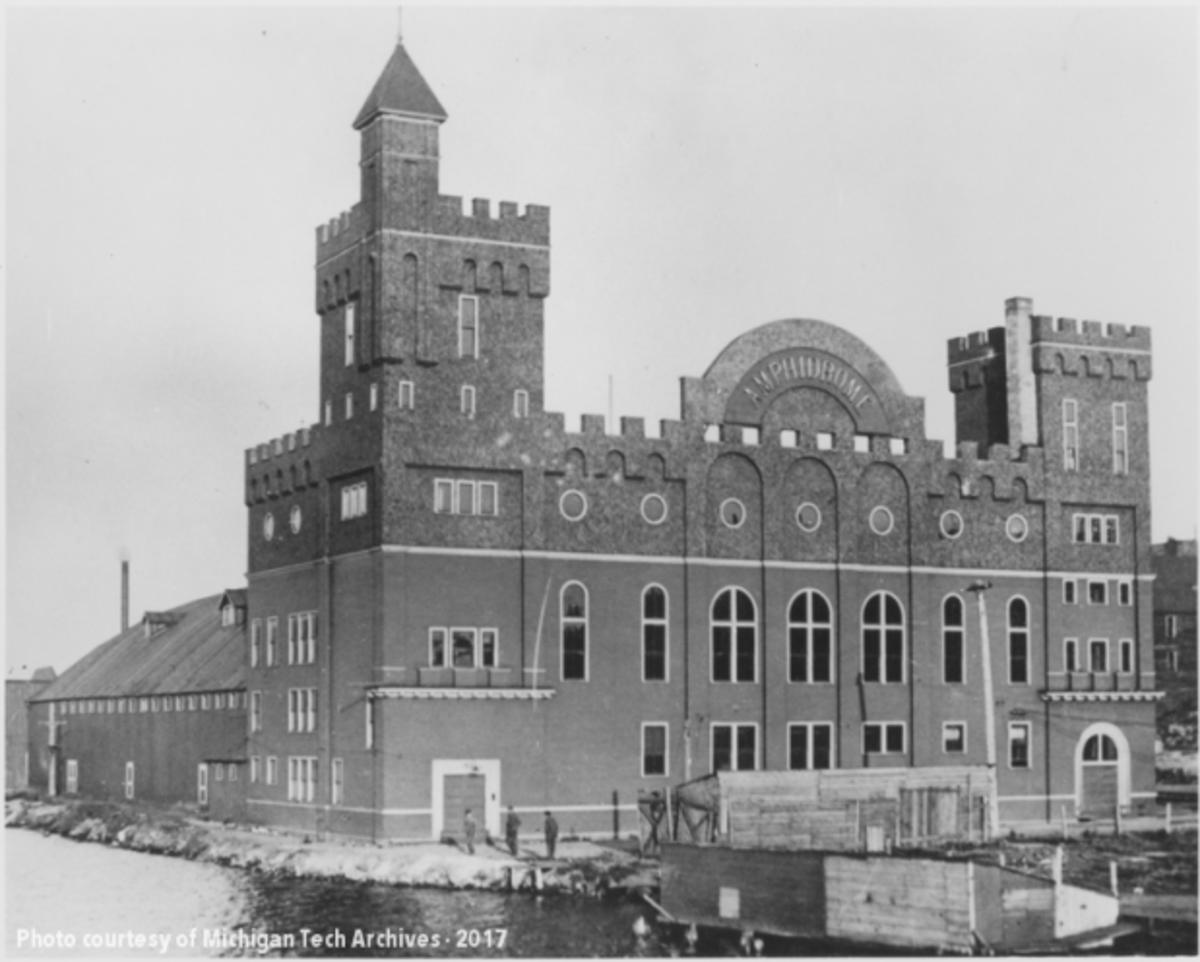
Historic early 1900's photograph of the Amphidrome in Houghton, prior to it burning down in 1927. (Photo courtesy of MTU Archives)
The newly built stadium was called “The New Amphidrome” until 1943, when Michigan Tech purchased the arena and renamed it the James R. Dee Stadium in honor of the local entrepreneur and hockey enthusiast who led the effort to rebuild the Amphidrome following the fire. The stadium is now a Michigan Historic Site and is the 6th oldest indoor ice rink still in use in the world!
The first organized professional hockey game was played in this location on December 29, 1902 between the Portage Lakes Hockey Club and the University of Toronto Hockey Club. Our local team beat the University of Toronto 13 to 2 in a riveting game attended by over 5,000 spectators. During that season, the Portage Lakes Hockey Club became the first hockey team to pay all its players, making it the first fully professional team. This is how Houghton earned its reputation as the “Birthplace of Professional Hockey.”
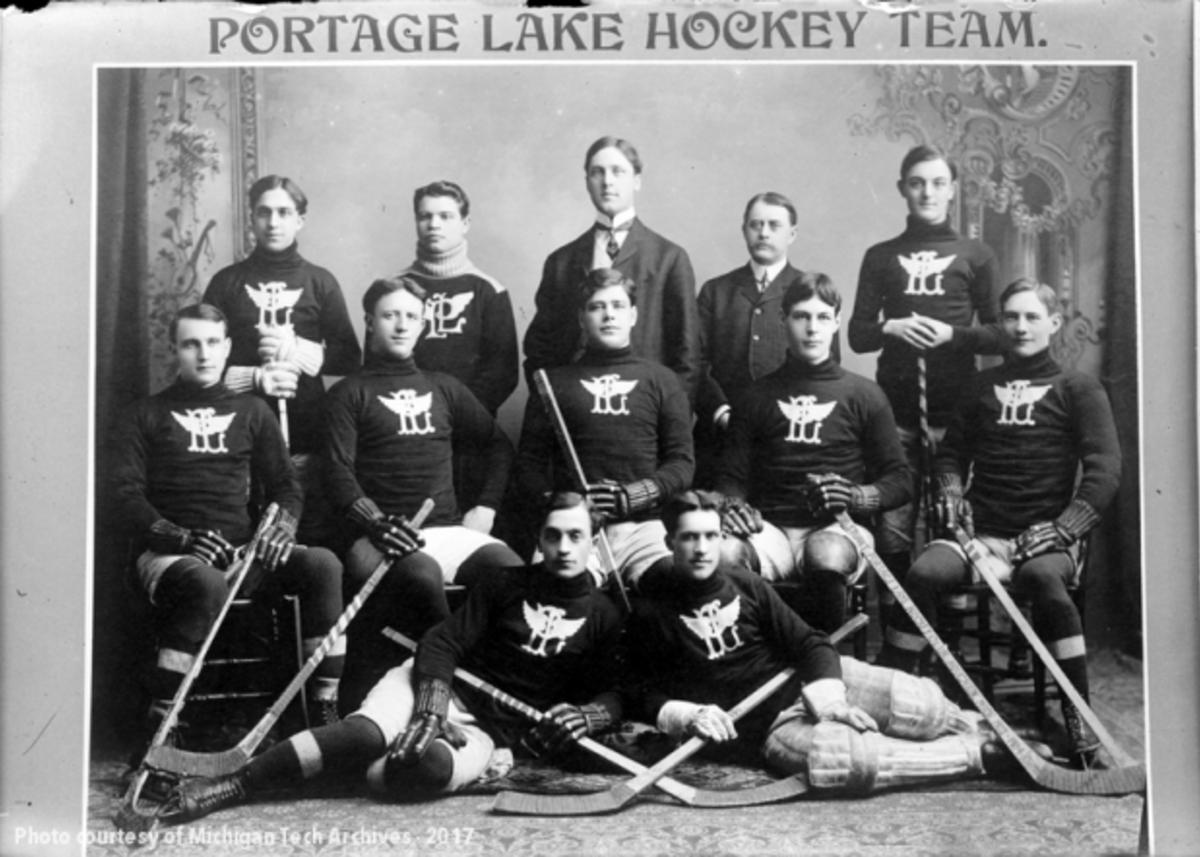
The 1903-1904 Portage Lake Hockey Club team. (Photo courtesy of Michigan Tech Archives)
In 1904, the Portage Lakes became part of the International Professional Hockey League, the first fully professional ice hockey league. The league was organized “Doc” Gibson with the assistance of James R. Dee and included five teams from Pittsburgh, PA, Sault Ste. Marie, MI, Sault Ste. Marie, Ontario, Calumet, MI, and Houghton, MI. “Doc” Gibson was the captain of the Portage Lakers and their best scoring player! He was inducted into the U.S. Hockey Hall of Fame in 1973 for his contributions to professional hockey in the United States.
In 1943, the Michigan College of Mining and Technology (now Michigan Tech) started using the Dee as their home ice. An artificial ice plant was installed in 1953 – a major facility improvement that was celebrated by a special dedication game between Michigan Tech and the Portage Lake Pioneers. This exciting game resulted in a 3-3 tie. Michigan Tech used this rink for many years, playing their last game at the Dee on December 4, 1971. At that time, construction of the MacInnes Student Ice Arena was complete, becoming Michigan Tech’s new home rink.
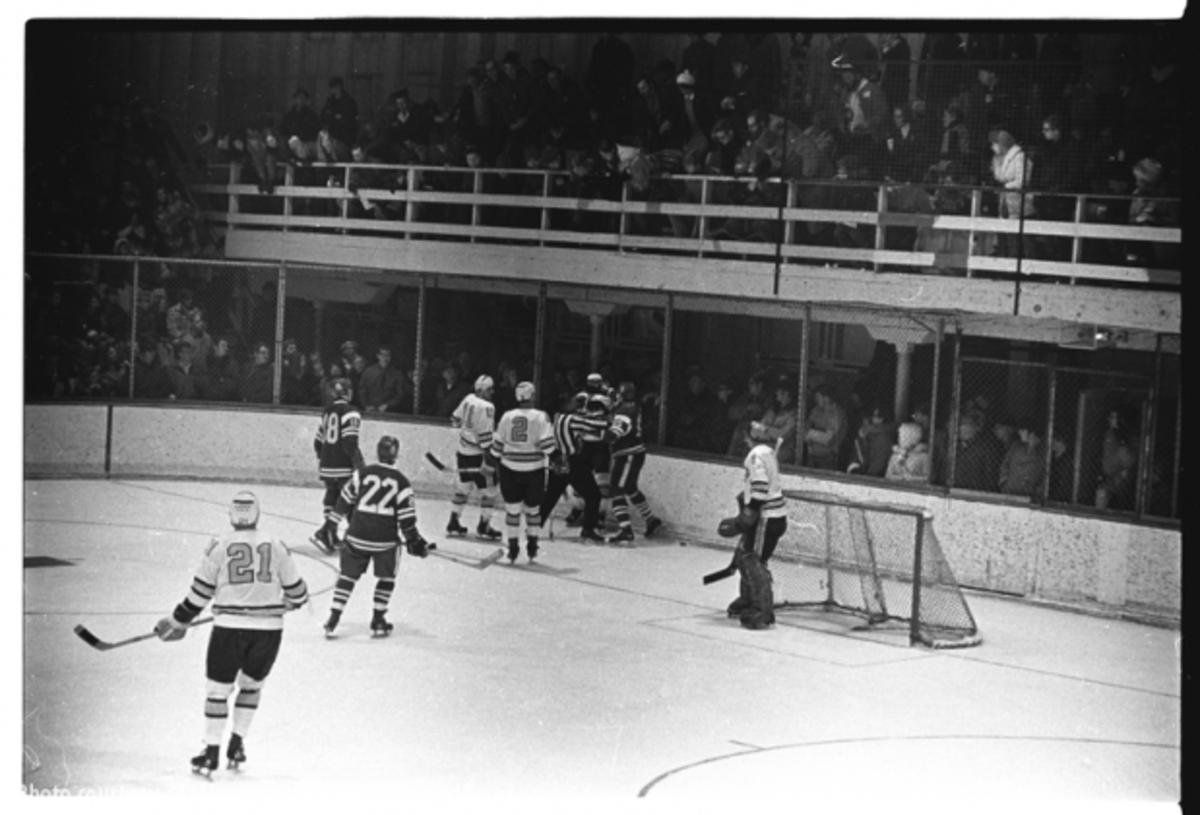
A Michigan Tech Hockey game at the Dee Stadium in 1970. (Photo courtesy of Michigan Tech Archives)
Today, the City of Houghton owns the Dee Stadium, and it is the home of the Houghton High School Gremlins Hockey Team and the Portage Lake Pioneers Senior Hockey Team. Be sure to check their season schedules so that you can root them on during a home game at the Dee.
Visitors are also encouraged to stop by the Dee Stadium to explore the History of Hockey Museum in the Kenner Ruohonen Memorial History Room. This exhibit offers a timeline of hockey history in the Keweenaw and information about our historic Keweenaw teams. It also features a nice collection of historic gear, photographs, and other prized memorabilia.
The MacInnes Student Ice Arena
The MacInnes Student Ice Arena was named after Michigan Tech’s most notable coach, John MacInnes. John J. MacInnes was nationally recognized at the time as being the highest winning coach in college history and was officially inducted into the U.S. Hockey Hall of Fame in 2007. Under his direction, Michigan Tech won the NCAA National Hockey Times three times! Prior to coaching at Michigan Tech, he played goalie for the University of Michigan, the Boston Bruins, and the Detroit Red Wings.
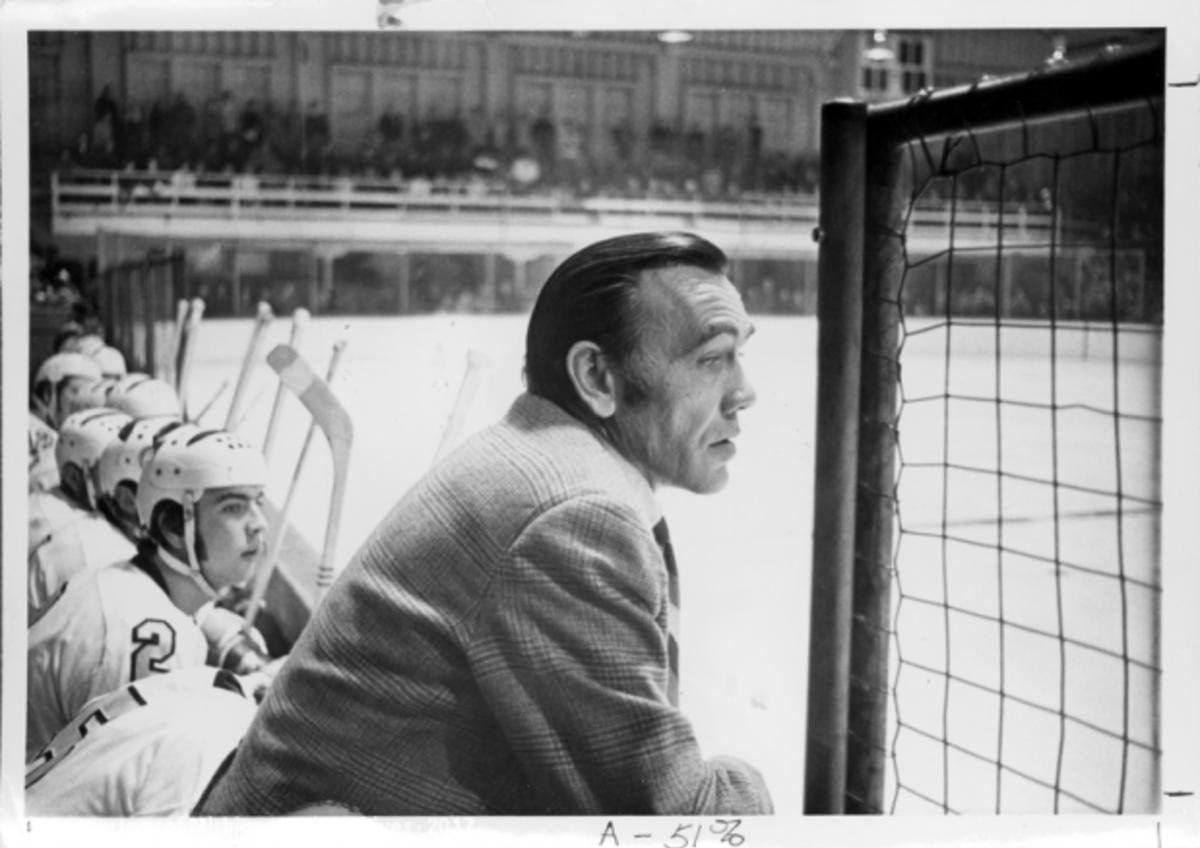
Coach MacInnes during the 1971-72 season. (Photo courtesy of Michigan Tech Archives)
The John J. MacInnes Student Ice Arena is a modern hockey venue that has seen significant upgrades throughout the years. It includes 14 luxury suites, six concession areas, a pro shop, training room, nine locker rooms, and a Puck Pit for players to practice their shooting skills. For over fifty years, the arena has been filled with triumphant sounds and lively cheers of Mitch’s Misfits rowdy student section, as well as the Michigan Tech Pep Band.
Michigan Tech’s NCAA Division I men’s hockey team has been highly successful, producing NHL standouts like Tony Esposito (1967), Bob Lorimer (1975), Randy McKay (1988), and John Scott (2010).

Tony Esposito guards the net during the 1964-65 season. (Photo courtesy of Michigan Tech Archives)
Lively crowds, the trumpeting pep band, and fun halftime games make Husky home hockey games an exciting and spirited experience for fans of all ages. So, grab some black and yellow merch from the Michigan Tech Campus Bookstore (located in the Memorial union Building) or University Images (in the Student Development Complex) and get ready to cheer on our Michigan Tech Huskies during their next home game.
Hancock’s Indoor Arenas
Houghton County Arena
Constructed in 1972, the Houghton County Arena (HoCo) is a public-owned facility that offers space for recreational and social activities. HoCo provides home ice for the Hancock High School Bulldogs and hosts the Copper Country Junior Hockey Association and the Copper Country Old-Timer's. The rink also provides weekly public open skating (bring your own skates). A complete schedule for Houghton County Ice Arena can be found here.
Calumet’s Indoor Rinks
Calumet Colosseum
Construction of the Calumet Colosseum began in 1913 with a formal opening on January 1, 1914. Featuring a three-story barrel roof structure, this important community arena is considered the oldest operating continuous-use indoor rink in the world! On January 6, 1914, the Calumet Wolverines and Portage Lake Pioneers competed in the Calumet Colosseum’s inaugural ice hockey game. A rivalry game between these two teams is always an exciting time and a Calumet tradition that has lived on through generations.
In January 1942, the National Guard Armory (located across the street) burnt down, and the Colosseum was sold to the State of Michigan. At that time, it was renamed the Calumet Armory and became home-base for the Calumet Detachment of the National Guard. In 1968, artificial ice was installed, and high school hockey returned to the arena for the first time since World War II. The National Guard eventually moved into a new armory in 2005 and Calumet Township took over the old armory building. At that time, the name was reverted to the Calumet Colosseum and became home of the Calumet Junior Hockey Association. Although the arena is once again formally known as the Calumet Colosseum, you will still hear many community members refer to it as the Armory.
In 2019, the Colosseum was recognized as the winner of Kraft Hockeyville USA. The Colosseum was awarded $150,000 for upgrades, which included a new ice plant, heating system, sound system, and refurbished locker rooms. The arena also had the opportunity to host an NHL pre-season game between the Detroit Red Wings and the St. Louis Blues. Tickets for this high-demand game were raffled to local community members and the 700-seat arena was packed with thrilled spectators for the exciting game.

Winner of Kraft Hockeyville in 2019, the Colosseum received major upgrades and hosted an NHL pre-season game.
The Calumet Colosseum is also home to the International Frisbee/USA Guts Hall of Fame. This unique museum is located in the second-floor ballroom, where visitors can learn about the intense sport of Guts frisbee and teams that have played in the Copper Country. Showcases with Copper Country hockey memorabilia can also be found on the first floor of the arena.
The thrill of the sport lives on in our Calumet arena. Visitors are encouraged to catch a game at the Colosseum, visit the museum inside, or attend open skating. Check the weekly schedule to see what’s happening next at the historic Calumet Colosseum.
The George Gipp Rink
Built in 1976, Laurium’s Gipp arena was originally called the Bi-Centennial Ice rink. The building was later renamed as a tribute to the famous Notre Dame football player, George Gipp, who grew up in the village of Laurium. This community ice arena is smaller than regulation, but it has served as a fantastic facility for younger players in the local Initiation or Mites Programs and offers public skating. This arena also hosts the Bi-Centennial Mite Tournament in late February each year. So, bring your ice skates, and attend a public ice-skating session in this lovely community rink.
Outdoor Rinks
Before the dawn of artificial ice, the game of ice hockey was born “on the pond.” The sound of the puck hitting the ice echoed through the air as players developed their skills.

Enjoying a game of hockey on the Portage Canal in 1914. (Photo courtesy of Michigan Tech Archives)
Today, there are many outdoor rinks throughout the region that offer space for casual hockey games and ice skating. Some of our most beloved outdoor rinks include the Dodgeville pavilion, Laurn-Grove in Hancock, the Emil Aho Memorial Ice Rink in Ahmeek, and the Chassell pavilion at Chassell Centennial Park. On rare (and super special) occasions, the Portage Canal will freeze perfectly, allowing skaters the opportunity to take in views of the Portage Lake Lift Bridge as they slap a puck around with friends.
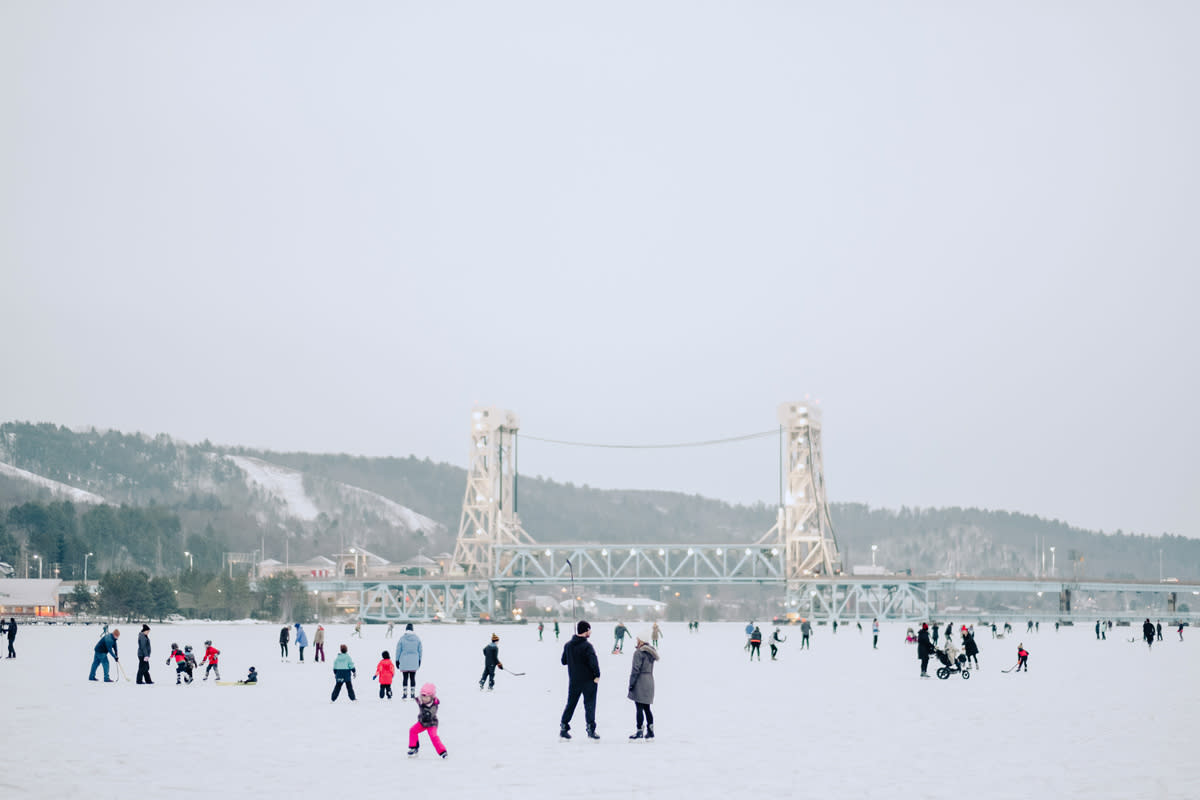
When the Portage Canal freezes perfectly, you will find community members out enjoying the ice.
Legendary Regional Hockey Trophies
As the Birthplace of Professional Hockey, you can bet that the Copper Country has some legacy awards that are well known throughout the Midwest.
MacNaughton Cup
The oldest of these awards is the prized MacNaughton Cup. This cup was funded by James MacNaughton, an avid supporter of amateur hockey and the superintendent of Calumet & Hecla Mining Company based in Calumet, MI. The cup is made of pure silver, standing at a height of nearly three feet, and weighing almost 40 pounds! It was purchased at a price of $2,000 in 1913, which equates to nearly $50,000 today.

Player Bill Steele poses with the MacNaughton Cup in 1974. (Photo courtesy of Michigan Tech Archives)
Originally, the cup belonged to the American Hockey Association, and later it was handed over to the Western Intercollegiate Hockey League (WIHL). WIHL included Michigan Tech, Colorado College, Denver, Michigan, Michigan State, Minnesota and North Dakota. When this league disbanded, the seven teams competed under a new name, the Western Collegiate Hockey Association (WHCA). Michigan Tech left WHCA in 1982 and joined the Central Collegiate Hockey Association. At that time, they took the MacNaughton Cup with them. Since then, Michigan Tech has been the trustee of the MacNaughton Cup, bringing it back to WHCA when they returned to the league during the 1984-1985 season. The cup is awarded at the end of the season to the conference winner.
*Information about the MacNaughton Cup was provided by https://www.techhockeyguide.com/past/macnaughton-cup/
“Doc” Gibson Cup
The famous “Doc” Gibson Cup has been around since 1939 and is often referred to as the “Stanley Cup of the North.” This rivalry cup is one of the most coveted hockey trophies in the Midwest and the third oldest tournament cup in hockey history. This silver-plated cup stands a little over two and a half feet tall and was originally awarded to the champion of the Northern Michigan-Ontario professional hockey league. During the late 1950’s and much of the 1960’s there was no series for the cup. After several years of inactivity, it became the rivalry trophy for an annual three-game series played between the Calumet Wolverines and the Portage Lake Pioneers. The Portage Lake Pioneers reclaimed the cup with a 3-2 victory over the Calumet Wolverines in 2023. They will compete for the cup again this season on the weekend of April 11-13.
Hockey Events You Won’t Want to Miss
Pigs-N-Heat Charity Hockey Game
The annual Pigs-N-Heat Charity Hockey game supports the Copper Country Police and Fire Relief Fund, an organization that serves citizens of Houghton and Keweenaw counties. This fun benefit is a lively game between local law enforcement agencies and local volunteer firefighters. It also includes raffles with thousands in prizes, including gun and cash raffles. Bring your whole family to the John MacInnes Student Ice Arena on February 16th to join in the fun of this exciting annual event!
Copper Country Old Timer’s Hockey Tournament
The Copper Country Old-Timers League hosts an annual St. Patrick's Day weekend tournament in the Keweenaw. Spectators can catch riveting (and fun) games at The Dee, Houghton County Arena, and the Calumet Colosseum. The Copper Country Old Timers Tournament consists of several different divisions with teams from across the Upper Peninsula. The league is a non-profit, social, sports and civic minded club that provides healthy, friendly, competition during the winter months. It is easy to feel the emphasis on sportsman-like conduct, brotherhood, and goodwill when attending these fun tournament games.
Calumet Wolverines V Portage Lake Pioneers Game
The Calumet Wolverines Hockey Club is fast-paced and exciting hockey club that is heavily involved in community events. The Wolverines play in a USA Hockey-affiliated full-check league (Great Lakes Hockey League) that consists of eight other teams in Wisconsin and Michigan, including their local arch rivals, the Portage Lake Pioneers. Games are lively and spirited with plenty of high scores, hard hits, and talented players. The team consists of many alumni of Calumet High School and the Calumet Junior Hockey Association.
Founded just after the start of the 20th century, the Portage Lake Pioneers is a Senior “A” Hockey Team and is considered one of the oldest hockey teams in the world. Another local member of the Great Lakes Hockey League, you can imagine the excitement of a game being played between the Portage Lake Pioneers and the Calumet Wolverines. This long-standing rivalry brings electric energy to our local stadiums throughout winter, especially during their annual Gibson Cup Weekend Series Event. Find more games on our events calendar.
Further Reading
The Copper Country celebrates its hockey history, and extensive research has been done to keep the legacy of former players and regional rinks alive. From the early days of outdoor rinks to the intense rivalries on the ice, every goal and penalty tells a story of a community deeply passionate about the sport.
Dr. William Sproule, a retired professor from Michigan Tech, spent many years researching the topic of local hockey history to discover what it meant for Houghton to be known as the “Birthplace of Professional Hockey.” In 2019, his book “Houghton: The Birthplace of Professional Hockey” hit the shelves, bringing this history to light. You can buy his book here or find it in one of our local gift shops or bookstores.
Connie Julien, three time Michigan Tech grad, who's sons grew up playing hockey here in Houghton, has also spent time researching and volunteering her time to create an online resource for learning about Copper Country hockey history. Her website provided tons of valuable information and insight for writing this blog. You can find her website here.
Please note that information in this blog is believed to be historically accurate, but feel free to contact us if you notice any details that may be out of place.
Interested in updates, travel tips and quirky information about the Keweenaw? Just sign up for the Keweenaw Explorer, our monthly e-newsletter. Complete the form…

